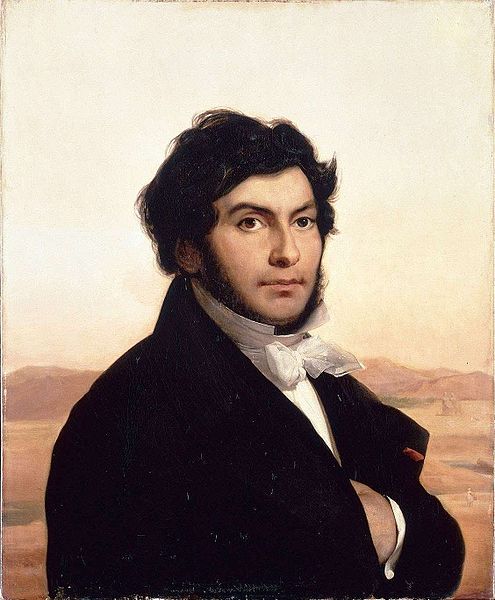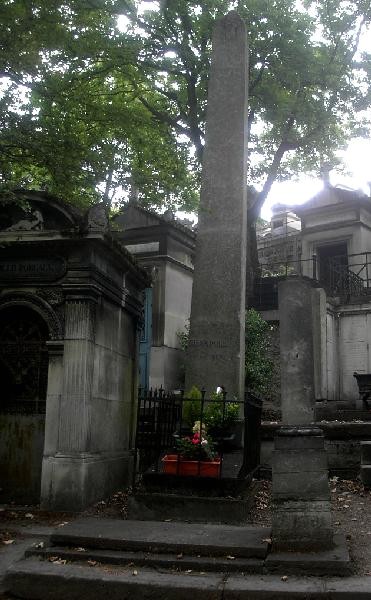<Back to Index>
- Egyptologist Jean François Champollion, 1790
- Writer Giuseppe Tomasi di Lampedusa, 1896
- Emperor and Autocrat of All the Russias Alexander I, 1777
PAGE SPONSOR


Jean-François Champollion (23 December 1790 – 4 March 1832) was a French classical scholar, philologist and orientalist, decipherer of the Egyptian hieroglyphs.
Champollion deciphered the hieroglyphs with the help of groundwork laid by his predecessors: Athanasius Kircher, Silvestre de Sacy, Johan David Akerblad, Thomas Young himself, and William John Bankes. Champollion translated parts of the Rosetta Stone in 1822, showing that the Egyptian writing system was a combination of phonetic and ideographic signs. Champollion was born in Figeac, Lot,
the last of seven children (two of whom had already died before he was
born). He was raised in humble circumstances; because his parents could
not afford to send him to school, and he was taught to read by his
brother Jacques. Jacques, although studious and largely self-educated, did not have
Jean-François' genius for language; however, he was talented at
earning a living, and supported Jean-François for most of his
life. He lived with his brother in Grenoble for several years, and even as a child showed an extraordinary linguistic talent. By the age of 16 he had mastered a dozen languages and had read a paper before the Grenoble Academy concerning the Coptic language. By 20 he could also speak Latin, Greek, Hebrew, Amharic, Sanskrit, Avestan, Pahlavi, Arabic, Syriac, Chaldean, Persian and Ge'ez in addition to his native French. In 1809, he became assistant-professor of History at Grenoble. His interest in oriental languages, especially Coptic, led to his being entrusted with the task of deciphering the writing on the then recently-discovered Rosetta Stone, and he spent the years 1822 – 1824 on this task. His 1824 work Précis du système hiéroglyphique gave birth to the entire field of modern Egyptology. He also identified the importance of the Turin King List, and dated the Dendera zodiac to the Roman period. His interest in Egyptology was originally inspired by Napoleon's Egyptian Campaigns 1798 – 1801. Champollion was subsequently made Professor of Egyptology at the Collège de France. Thomas Young was one of the first to attempt decipherment of the Egyptian hieroglyphs, basing his own work on the investigations of Swedish diplomat Åkerblad, who built up a demotic alphabet
of 29 letters (15 turned out to be correct) and translated all personal
names and other words in the Demotic part of the Rosetta Stone in
1802. Åkerblad however, wrongly believed that demotic was
entirely phonetic or alphabetic. Young thought the same, and by 1814 he
had completely translated the enchorial (which Champollion labeled
Demotic as it is called today) text of the Rosetta Stone (he had a list
with 86 demotic words). Young then studied the hieroglyphic alphabet and made some progress but failed to recognise that demotic and hieroglyphic texts were paraphrases and not simple translations. In 1823 he published an Account of the Recent Discoveries in Hieroglyphic Literature and Egyptian Antiquities. Some of Young's conclusions appeared in the famous article Egypt he wrote for the 1818 edition of the Encyclopædia Britannica. When
Champollion, in 1822, published his translation of the hieroglyphs and
the key to the grammatical system, Young and all others praised this
work. Young had indicated in a letter to Gurney that he wished to see
Champollion acknowledge that he had made use of Young's earlier work in
assisting his eventual deciphering of hieroglyphics. Champollion was
unwilling to share the credit even though initially he had not
recognized that hieroglyphics were phonetic. Young corrected him on this, and Champollion attempted to have an early article withdrawn once he realized his mistake.
Strongly motivated by the political tensions of that time, the British
supported Young and the French Champollion. Champollion completely
translated the hieroglyphic grammar based
in part upon the earlier work of others including Young. However,
Champollion maintained that he alone had deciphered the hieroglyphs.
After 1826, he did offer Young access to demotic manuscripts in the Louvre, when he was a curator. Baron Georges Cuvier (1825) credited Champollion's work as an important aid in dating the Dendera Zodiac. In 1827 Ippolito Rosellini, considered the founder of Egyptology in Italy, went to Paris for a year in order to improve his knowledge of the method of decipherment proposed by Champollion. The two philologists decided
to organize an expedition to Egypt to confirm the validity of the
discovery. Headed by Champollion and assisted by Rosellini his first
disciple and great friend, the mission was known as the Franco-Tuscan
Expedition, and was made possible by the support of the grand-duke of Tuscany, Leopold II, and the King of France, Charles X. On the 21st of July 1828, with four members, they boarded the ship Eglé at Toulon and set sail for Egypt. They travelled upstream along the Nile and studied an exhaustive number of monuments and inscriptions. The expedition led to a posthumously published extensive Monuments de l'Égypte et de la Nubie (1845).
Unfortunately, Champollion's expedition was blemished by instances of
unchecked looting. Most notably, while studying the Valley of the Kings, he irreparably damaged KV17, the tomb of Seti I, by physically removing two large wall sections with mirror-image scenes. The scenes are now in the collections of the Louvre and the museum of Florence. Exhausted by his labours during and after his scientific expedition to Egypt, Champollion died of an apoplectic attack in Paris in 1832 at the age of 41. He is buried in the Père Lachaise cemetery. Certain portions of Champollion's works were edited by his elder brother, Jacques Joseph Champollion-Figeac; Jacques Joseph's son, Aimé-Louis (1812 – 1894), wrote a biography of the two brothers.